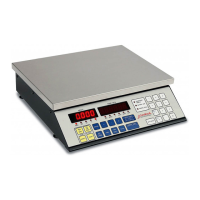SAMPLING AND COUNT ACCURACY
This section describes certain conditions that determine the accuracy of a parts counting
operation and procedures you can follow to assure optimum performance of your Digital
Counting Scale. Accurate counts depend upon the following conditions:
Functional accuracy of the scale.
Individual part weight variance.
Determination of parts sampling quantities.
Variance of container weights in tare operations.
ACCURACY OF THE SCALE (Refer to Figure No. 9)
TYPICAL CONDITION ACCURACY - on a stable surface, applied load less than 70% of scale
capacity, with no air currents or vibrations present, using parts with weight variance less than
1%; the total weight of all parts in the sample must be:
0.2% (1/500) of scale capacity for 99.5% accuracy
0.1% (1/1000) of scale capacity for 99% accuracy.
WORST CASE ACCURACY - on an unstable surface, applied load near 100% of scale capacity,
with air currents or vibrations present, using parts with weight variance less than 1%; the total
weight of all parts in the sample must be:
0.5% (1/200) of scale capacity for 99.5% accuracy
Counting accuracy will be greater than 99.5% when the total weight of all parts in the sample
exceeds 0.5% of scale capacity.
31
COUNT ACCURACY PERCENT
0% .5% 1.0%
100%
99.5%
99%
98.5%
98%
97.5%
WORST CASE
TYPICAL CONDITION
% OF SAMPLE
WEIGHT VS.
GROSS
CAPACITY
Figure No. 9

